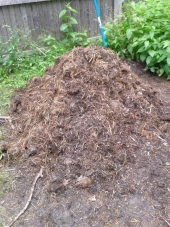I've been reading through Sepp Holzer's Permaculture and in the gardening chapter he briefly talks about his own composting method using raised beds:
"Composting is a way of producing high-quality fertilizer from organic waste. It is by no means necessary for a high-yield garden to have a
compost heap. Mulching throughout the year and the skillful use of polycultures mean that additional organic fertilizer is not necessary. However, anyone who wants to compost anyway, can easily create an unconventional and easy-to-maintain compost heap. To do this, two raised beds running parallel to each other should be positioned so closely to each other that you can only just walk between them. The beds should be built at as steep an angle as possible whilst still holding together (60 to 70 degrees). Organic waste is left between the two beds each day. Each time you do this, cover the waste with a spade's worth of earth, straw, leaves or similar material. Gradually, the organic material will come up to 60 percent of the height of the raised beds. The top layer should be covered with earth and planted or sown with vigorous growing vegetables (pumpkins, cucumbers, turnips etc.). Start at the furthest end of the bed and keep going until the gap is filled up. The best situation is when the dimensions of the compost heap ensure that the gap can be filled and will rot down within a year. The next year you can begin on the opposite side and throw the high-quality compost that was made the previous year on the beds to the left and right with a spade. As many earthworms will be living in there, you should be careful when digging. Afterwards, you can walk through the furrow that is left or climb over one of the raised beds to the side. Planks or large stones can be used to walk on. Using this method you can cultivate vegetables and compost and breed earthworms in a very small space.
"Any conceivable type of material can be used for composting: grass clippings, chipped material, leaves, hay, straw, algae or mud from a pond, kitchen waste, cardboard etc. - any organic material that decomposes is suitable. The smaller the material and the more active the soil life is, the faster the decomposition process. The plants growing on the raised beds should be chosen so that the compost still gets enough light, but is also protected from the sun. In partial shade the optimal conditions for the decomposition process develop and the compost quickly turns into the highest quality manure."
Thoughts? Has anyone tried this method? Would animal manure be a suitable input? What about humanure?
Every day, every season there is change, something new to observe, and constant learning. Permaculture has the dimensions of a life-oriented chess game, involving the elements, energy, and the dimensions of both life-forms and building structures (also with political, social, financial, and global implications).







